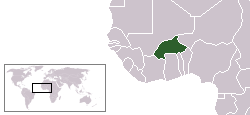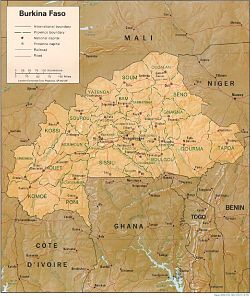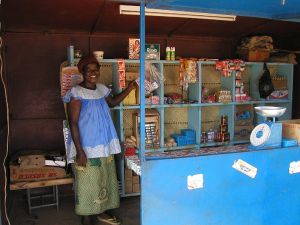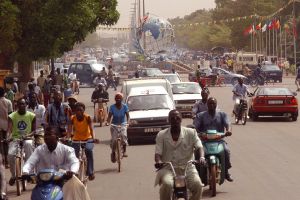Difference between revisions of "Burkina Faso" - New World Encyclopedia
Vicki Phelps (talk | contribs) m (→External links) |
Vicki Phelps (talk | contribs) |
||
| Line 101: | Line 101: | ||
There is mineral exploitation of [[copper]], [[iron]], [[manganese]], and, above all, [[gold]]. | There is mineral exploitation of [[copper]], [[iron]], [[manganese]], and, above all, [[gold]]. | ||
| − | |||
[[Image:Burkina Faso - Tarfila Farming Group.jpg|thumb|Tarfila Farming Group]] | [[Image:Burkina Faso - Tarfila Farming Group.jpg|thumb|Tarfila Farming Group]] | ||
[[Image:Burkina Faso - Madame Badoun.jpg|thumb|Shop in Burkina Faso]] | [[Image:Burkina Faso - Madame Badoun.jpg|thumb|Shop in Burkina Faso]] | ||
| Line 120: | Line 119: | ||
The [[United Nations]] Development Program Report places Burkina Faso as the most illiterate country in the world, with only a 12.8 percent literacy rate. Education is technically free and officially mandatory until the age of 16; however, few Burkinabè have had formal education. Though schooling is free, attendance is not enforced, and only about 35 percent of Burkina's primary school-age children receive a basic education. Institutions of higher education include the University of Ouagadougou and the Polytechnical University in Bobo-Dioulasso. | The [[United Nations]] Development Program Report places Burkina Faso as the most illiterate country in the world, with only a 12.8 percent literacy rate. Education is technically free and officially mandatory until the age of 16; however, few Burkinabè have had formal education. Though schooling is free, attendance is not enforced, and only about 35 percent of Burkina's primary school-age children receive a basic education. Institutions of higher education include the University of Ouagadougou and the Polytechnical University in Bobo-Dioulasso. | ||
| − | + | ==Culture== | |
| + | Burkina Faso hosts the International Art and Craft Fair, better known by its French name as SIAO, one of the most important African handicraft fairs. Burkina Faso itself is well known for its elaborate carved wooden masks, as well as pottery, wood carving, and other items associated with animist rituals. Attached to the masks are costumes made of fibers that hang to the ground. The masks belong to families and appear at burials, funerals of clan elders, initiations, and other important occasions. In animist traditions, masks are the reincarnation of the animal totem, the spirits of important ancestral elders, and of the collective spirits of the clan's ancestors. They protect and aid the members of the clan and serve as portable altars for sacrifices to the ancestors. | ||
==References== | ==References== | ||
| − | + | * Christopher D. Roy, "The Art of Burkina Faso" [http://www.uiowa.edu/~africart/Art%20of%20Burkina%20Faso.html], observed December 29, 2006. | |
| − | |||
| − | |||
==External links== | ==External links== | ||
===Culture=== | ===Culture=== | ||
*[http://www.fespaco.bf/index_en.html Panafrican Film and Television Festival of Ouagadougou (FESPACO)] | *[http://www.fespaco.bf/index_en.html Panafrican Film and Television Festival of Ouagadougou (FESPACO)] | ||
| − | |||
*[http://www.burkinabe.be/en/ Photos and stories of life in the North of Burkina Faso] | *[http://www.burkinabe.be/en/ Photos and stories of life in the North of Burkina Faso] | ||
*[http://www.helge.at/photos/burkina2003/ Photos from Burkina Faso] | *[http://www.helge.at/photos/burkina2003/ Photos from Burkina Faso] | ||
Revision as of 22:47, 31 December 2006
| Burkina Faso | ||||||
|---|---|---|---|---|---|---|
|
||||||
| Motto: "Unité, Progrès, Justice" French]]) "Unity, Progress, Justice") |
||||||
| Anthem: Une Seule Nuit French "One Single Night" |
||||||
| Capital (and largest city) | Ouagadougou 12°20′N 1°40′W | |||||
| Official languages | French | |||||
| Government | Parliamentary system | |||||
| Independence | ||||||
| Area | ||||||
| - | Total | 274,000 km² (74th) Expression error: Unexpected div operator. sq mi |
||||
| - | Water (%) | 0.1% | ||||
| Population | ||||||
| - | 2005 estimate | 13,228,000 (66th) | ||||
| - | 1996 census | 10,312,669 | ||||
| GDP (PPP) | 2005 estimate | |||||
| - | Total | $16.845 billion1 (117th) | ||||
| - | Per capita | $1,284 (163rd) | ||||
| Currency | CFA franc (XOF) |
|||||
| Time zone | GMT | |||||
| Internet TLD | .bf | |||||
| Calling code | +226 | |||||
| 1 The data here is an estimation for the year 2005 produced by the IMF in April 2005. | ||||||
Burkina Faso is a landlocked nation in West Africa. Formerly the Republic of Upper Volta, it was renamed on August 4, 1984 by President Thomas Sankara to mean "the land of upright people" (or "upright land") in Mossi and Dioula, the major native languages of the country. Independence from France came in 1960. Governmental instability during the 1970s and 1980s was followed by multiparty elections in the early 1990s. Several hundred thousand farm workers migrate south every year to Côte d'Ivoire and Ghana in search of paid labor. The inhabitants of Burkina Faso are known as Burkinabè or Burkinabé (pronounced [burkiːnəˈbeː]).
History
Prehistory
Like all of the west of Africa, Burkina Faso was populated early, notably by hunter-gatherers in the northwestern part of the country (12,000 to 5000 B.C.E.), and whose tools (scrapers, chisels, and arrowheads) were discovered in 1973. Settlements appeared between 3600 and 2600 B.C.E. with farmers, the traces of whose structures leave the impression of relatively permanent buildings. The use of iron, ceramics, and polished stone developed between 1500 and 1000 B.C.E., as well as a preoccupation with spiritual matters, as shown by the burial remains that have been discovered.
Relics of the Dogon are found in the center-north, north and north west regions. They left the area between the fifteenth and sixteenth centuries B.C.E. to settle in the cliffs of Bandiagara. Elsewhere, the remains of high walls are localized in the southwest of Burkina Faso (as well as in the Côte d'Ivoire), but the people who built them have not yet been definitely identified.
Burkina Faso was a very important economic region for the Songhai Empire during the fifteenth and sixteenth centuries.
From colony to independence
In 1896, the Mossi kingdom of Ouagadougou became a French protectorate after being defeated by French forces. In 1898, the majority of the region corresponding to Burkina Faso today was conquered. In 1904, these territories were integrated into French West Africa in the heart of the Upper-Senegal-Niger colony.
It was originally administered as part of Côte d'Ivoire but became a separate colony in 1919. The new colony of Upper-Volta was broken up in 1932 and shared between the Côte d’Ivoire, Mali, and Niger.
In 1947 Upper Volta was re-created with its 1932 boundaries, and in 1958, it achieved self-government and became a republic and member of the Franco-African Community. Full independence was attained in 1960. The country's first military coup occurred in 1966; it returned to civilian rule in 1978. There was another coup, led by Saye Zerbo in 1980, which in turn was overthrown in 1982. A counter-coup was launched in 1983, which left Captain Thomas Sankara in charge. The current president is Blaise Compaoré, who came to power in 1987 after a coup d'état that killed Sankara.
Politics
The constitution of June 2, 1991, established a semi-presidential government with an Assembly that can be dissolved by the president, who is elected for a term of five years. The year 2000 saw a constitutional amendment reducing the presidential term from seven to five years, which was enforced during the 2005 elections. Another change according to the amendment would have prevented sitting president Blaise Compaoré from being re-elected. However, notwithstanding a challenge by other presidential candidates, in October 2005 the constitutional council ruled that because Compaoré was already a sitting president in 2000, the amendment would not apply to him until the end of his second term in office. This cleared the way for his candidacy in the 2005 election, and he was reelected in a landslide due to a divided political opposition.
The parliament consists of two chambers. There is also a constitutional chamber, composed of ten members, and an economic and social council whose roles are purely consultative.
Burkina Faso is divided into 13 regions, 45 provinces, and 301 departments.
Geography
Burkina Faso is surrounded by six countries: Mali to the north, Niger to the east, Benin to the southeast, Togo and Ghana to the south, and Côte d'Ivoire to the southwest.
The country has two major types of countryside:
- The larger part of the country is covered by a peneplain that forms a gently undulating landscape with, in some areas, a few isolated hills, the last vestiges of a precambrian massif.
- The southwest forms a sandstone massif, where the highest peak is found: Ténakourou, 2,450 ft (749 m). The massif is bordered by sheer cliffs up to 490 ft (150 m) high. The average altitude is 1,300 ft (400 meters), nd the difference between the highest and lowest terrain is no greater than 2,000 ft (600 meters). Burkina Faso is therefore a relatively flat country, with a very few localized exceptions.
The country owed its former name of Upper Volta to three rivers that cross it: the Mouhoun (formerly called the Black Volta), the Nakambé (the White Volta),and the Nazinon (the Red Volta). The Mouhoun, along with the Comoé that flows to the southwest, is the country's only river to flow year-round. The basin of the Niger River also drains 27 percent of the country's surface. Its tributaries (the Béli, the Gorouol, the Goudébo, and the Dargol) are seasonal streams and only flow for four to six months a year but can cause large floods. The country also contains numerous lakes.
Water shortages are often a problem, especially in the north of the country.
Climate
Burkina Faso has a primarily tropical climate with two very distinct seasons: the rainy season, which lasts approximately four months (May/June to September), and the dry season during which the harmattan blows, a hot dry wind from the Sahara.
Three major climatic zones can be defined:
- The Sahel Zone in the north, which typically receives less than 24 inches (600 mm) rainfall a year. A relatively dry tropical savanna, the Sahel extends beyond the borders of Burkina Faso, from the Horn of Africa to the Atlantic Ocean, and borders the Sahara to its north, and the fertile region of the Sudan to the south.
- The Sudan-Sahel region, a transitional zone with regards to rainfall and temperature.
- The Sudan-Guinea zone farther to the south, which receives more than 35 inches (900 mm) of rain a year and has cooler average temperatures.
Economy
Burkina Faso is one of the poorest countries in the world, with a GDP per capita income of $1,300. This can be attributed to population growth and arid soil. Agriculture represents 32 percent of its gross domestic product and occupies 80 percent of the working population. It consists mostly of livestock but also, especially in the south and southwest, of crops such as sorghum, millet, maize (corn), peanuts, rice, and cotton.
Lack of work causes a high rate of emigration: for example, three million people from Burkina Faso live in Côte d'Ivoire. According to the Central Bank of Western African States, these migrants send tens of billions of CFA francs back to Burkina Faso each year. Since the 1967 expulsions from Ghana, this situation has provoked tensions in the destination countries. The crisis of 2003 in Côte d'Ivoire led to the return of 300,000 migrants.
A large part of the economic activity of the country is funded by international aid.
There is mineral exploitation of copper, iron, manganese, and, above all, gold.
Demographics
Burkina Faso has an estimated life expectancy at birth of slightly under 50 years of age. The median age of its inhabitants is under 17.
The population growth rate is 2.71 percent (2000 est.) Population estimates take into account the effects of excess mortality due to AIDS; this can result in lower life expectancy, higher infant mortality and death rates, lower population and growth rates, and changes in the distribution of population by age and sex than would otherwise be expected (July 2000 est.): the 11,946,065 Burkinabè belong to two major West African cultural groups—the Voltaic and the Mande. The Voltaic are far more numerous and include the Mossi, who make up about one-half of the population. Additionally, about 5,000 Europeans live in Burkina Faso.
The population is concentrated in the south and center of the country, sometimes exceeding 48 per square kilometer (125/sq. mi.). This high population density, causes annual migrations of hundreds of thousands, for seasonal employment.
Approximately 50 percent of the population is Muslim; Christians account for about 30 percent, and followers of traditional African religions (typically animism of various forms) make up about 20 percent. Many Christians and Muslims incorporate elements of animism into their religious practices.
Education
The United Nations Development Program Report places Burkina Faso as the most illiterate country in the world, with only a 12.8 percent literacy rate. Education is technically free and officially mandatory until the age of 16; however, few Burkinabè have had formal education. Though schooling is free, attendance is not enforced, and only about 35 percent of Burkina's primary school-age children receive a basic education. Institutions of higher education include the University of Ouagadougou and the Polytechnical University in Bobo-Dioulasso.
Culture
Burkina Faso hosts the International Art and Craft Fair, better known by its French name as SIAO, one of the most important African handicraft fairs. Burkina Faso itself is well known for its elaborate carved wooden masks, as well as pottery, wood carving, and other items associated with animist rituals. Attached to the masks are costumes made of fibers that hang to the ground. The masks belong to families and appear at burials, funerals of clan elders, initiations, and other important occasions. In animist traditions, masks are the reincarnation of the animal totem, the spirits of important ancestral elders, and of the collective spirits of the clan's ancestors. They protect and aid the members of the clan and serve as portable altars for sacrifices to the ancestors.
ReferencesISBN links support NWE through referral fees
- Christopher D. Roy, "The Art of Burkina Faso" [1], observed December 29, 2006.
External links
Culture
- Panafrican Film and Television Festival of Ouagadougou (FESPACO)
- Photos and stories of life in the North of Burkina Faso
- Photos from Burkina Faso
- Photographs of daily life in Burkina Faso (1970-2004)
- Listen to "Fulbe" (Fulani) music
- Women authors fom Burkina Faso at a glance
- Encyclopedia of the Nations : Burkina Faso
Government and organizations
- Premier Ministère official government portal (in French)
- Embassy of Burkina Faso in Washington, DC government information and links
- Aid organization, photos and videos from Burkina Faso
News
- allAfrica - Burkina Faso news headline links
Overviews
- BBC News - Country Profile: Burkina Faso
- Encyclopaedia Britannica, Country Page - Burkina Faso
- CIA World Factbook entry on Burkina Faso
Directories and portals
- Open Directory Project - Burkina Faso directory category
- Stanford University - Africa South of the Sahara: Burkina Faso directory category
- University of Pennsylvania - African Country Studies: Burkina Faso
- Yahoo! - Burkina Faso directory category
- OuagaNet.com: A portal site about Burkina Faso English/French
- Burkina Faso map and information page by World Atlas
- Burkina Faso's location on a 3D globe (Java)
- Africa : Burkina Faso
Credits
New World Encyclopedia writers and editors rewrote and completed the Wikipedia article in accordance with New World Encyclopedia standards. This article abides by terms of the Creative Commons CC-by-sa 3.0 License (CC-by-sa), which may be used and disseminated with proper attribution. Credit is due under the terms of this license that can reference both the New World Encyclopedia contributors and the selfless volunteer contributors of the Wikimedia Foundation. To cite this article click here for a list of acceptable citing formats.The history of earlier contributions by wikipedians is accessible to researchers here:
The history of this article since it was imported to New World Encyclopedia:
Note: Some restrictions may apply to use of individual images which are separately licensed.










